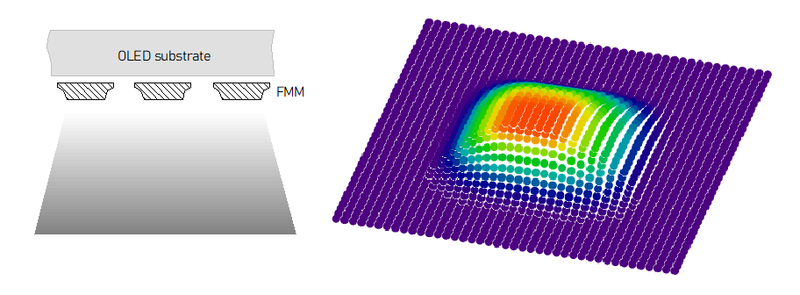Application Notes, December 2023
Application of V-Grade 5S series programs: OLED
Manufacturing of organic light-emitting diodes (OLED) display devices employs vacuum processes to deposit light-emitting materials in pixel arrays, which are typically formed with the help of a fine metal mask (FMM) featuring micrometer-size perforations. An alternative technique makes use of open metal masks (OMM) which are less difficult to produce than FMM. In the following we consider processes with FMM for representation.
Performance of an OLED device, to a great extent, depends on the FMM design in relation to vapor source(s) in use, quality of the manufactured FMM and its placement against the substrates, which may be rigid or flexible. A few geometric factors are important in ensuring that the deposited materials meet the requirements. Examples of local parameters are MMF thickness, profile (cross-section), and elevation from the substrate, while global geometry determining how uniformly a material is deposited from one area of a OLED substrate to another.
Tin Model's V-Grade 5S series software is ideally suited for numerical modeling of thin-film deposition processes for OLED. The accuracy and versatility of the software allow engineers to optimize their processes at ease. Among other purposes, it can be employed to build, study and optimize:
- MMF profile, i.e. cross-section
- MMF elevation
- MMF bending
- MMF positioning tolerance
- Point-like sources (effusion cells)
- Extended sources (line or plane)
- Substrate movement: rotational
- Substrate movement: translational
- Flat or curved substrates
- Textured substrates
The result of the modeling is a realistic rendering of the deposited material in 2D or 3D. For example, the following shows how different mask elevation causes the profile of the deposited dot to change. The mask has a square perforation of width W; the mask thickness is 0.125W; the source is a large plane source; the substrate undergoes a single rotation; the deposited dot is located a distance from the rotation axis. The profiles of deposited dots at different areas of the substrate can also be conveniently sampled for comparison.
Copyright © 2023-2024 Tin Model LLC. All rights reserved.
Selection or construction of the vapor source is another major focus of any OLED manufacturing. No one type of vapor source is inherently superior than other types -- it depends on how they are deployed in a coating process. V-Grade 5S series software can conveniently model sources of all types: from point-like effusion cells to transfer-replenished plane sources.
V-Grade 5S is capable of modeling imperfections in these sources, such as non-uniform emission due to heating nonuniformity of a plane source. It can also be employed to model constructions of effusion sources, such as different geometries of hot crucible walls and their effects on deposited materials.
As with models for other processes, V-Grade 5S models for OLED also yield production-related quantities, including vapor collection efficiency and raw-material consumption (the computed thickness values are in unit of "nm per gram of source material vaporized"). The latest release in the series, i.e. V-Grade 5S Pro, also calculates deposition rates. All aspects combined, V-Grade 5S Pro can provide these production quantities for a given manufacturing process:
- Raw material consumption for given quantity of OLED panels
- Time of material deposition (via deposition rates)
- Throughput for a given deposition process
- Projection of device yield (via quality analyses)
- Energy consumption (in relation to deposition rates)
In summary, V-Grade 5S series software offers a broad set of modeling tools for engineering and production of OLED devices. As has been proven in many industries, these tools catalyze innovations and streamline the development of OLED devices, from process conception to physical details, from cost analysis to production planning.
Although we have chosen processes with FMM for the discussion above, the findings and recommendations are applicable to both FMM and OMM.
Mask elevation = 0.25W Mask elevation = 0.5W Mask elevation = 0.75W



